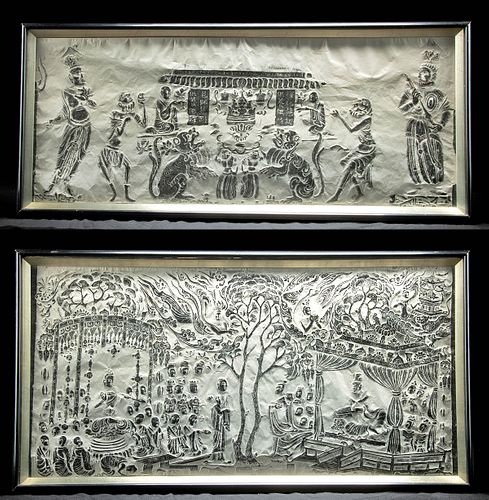Two Vintage Chinese Rubbings, Temple & Paradise Scenes
Lot 185
About Seller
Artemis Gallery
686 S Taylor Ave, Ste 106
Louisville, CO 80027
United States
Selling antiquities, ancient and ethnographic art online since 1993, Artemis Gallery specializes in Classical Antiquities (Egyptian, Greek, Roman, Near Eastern), Asian, Pre-Columbian, African / Tribal / Oceanographic art. Our extensive inventory includes pottery, stone, metal, wood, glass and textil...Read more
Categories
Estimate:
$800 - $1,200
Absentee vs Live bid
Two ways to bid:
- Leave a max absentee bid and the platform will bid on your behalf up to your maximum bid during the live auction.
- Bid live during the auction and your bids will be submitted real-time to the auctioneer.
Bid Increments
| Price | Bid Increment |
|---|---|
| $0 | $25 |
| $300 | $50 |
| $1,000 | $100 |
| $2,000 | $250 |
| $5,000 | $500 |
| $10,000 | $1,000 |
| $20,000 | $2,500 |
| $50,000 | $5,000 |
| $100,000 | $10,000 |
| $200,000 | $20,000 |
About Auction
By Artemis Gallery
Jun 24, 2021
Set Reminder
2021-06-24 10:00:00
2021-06-24 10:00:00
America/New_York
Bidsquare
Bidsquare : VARIETY SALE | Ancient & Ethnographic Art
https://www.bidsquare.com/auctions/artemis-gallery/variety-sale-ancient-ethnographic-art-7119
Featuring classical antiquities, ancient and ethnographic art. Egyptian, Greek, Roman, Etruscan, Near Eastern, Asian, Pre-Columbian, Native American, African / Tribal, Oceanic, Spanish Colonial, Russian, Fossils, Fine Art, more! All legally acquired, legal to sell. Satisfaction guaranteed. Artemis Gallery info@artemisgallery.com
Featuring classical antiquities, ancient and ethnographic art. Egyptian, Greek, Roman, Etruscan, Near Eastern, Asian, Pre-Columbian, Native American, African / Tribal, Oceanic, Spanish Colonial, Russian, Fossils, Fine Art, more! All legally acquired, legal to sell. Satisfaction guaranteed. Artemis Gallery info@artemisgallery.com
- Lot Description
East Asia, China, ca. third quarter of 20th century CE. A pair of beautiful rubbings of original temple carvings, one depicting a temple scene and the other depicting a paradise scene - featuring the imagined celestial realm occupied by deities and Bodhisattvas. Handmade rubbings have served to preserve China's visual culture and history for over 1500 years. They are created by pressing sheets of wet handmade paper into stone carvings and then carefully inking the surface to create an image. The black ink field surrounds the white impressions. Given the wear and deterioration to cherished stone monuments, such rubbings are oftentimes the only means of preserving China's heritage. Size of larger rubbing: 40.5" W x 20.25" H (102.9 cm x 51.4 cm) Size of frame: 44.375" W x 23.5" H (112.7 cm x 59.7 cm)
According to the Field Museum of Chicago, Illinois, "Although there are no precise records regarding the origins of rubbings, rubbings were being made of stone inscriptions of classic Confucian, Buddhist, and Daoist texts for scholarly and religious use soon after the invention of paper by around 100 A.D. (attributed to an official of the imperial court named Cai Lun, although recent archaeological discoveries indicate this probably took place a century earlier). The earliest known Chinese rubbings date to between 627 and 649 A.D. during the Tang Dynasty, and the collection of rubbings as an important cultural practice was recorded as early as the Five Dynasties period (907–960 A.D.).
In the Song Dynasty (960–1279 A.D.), jin shi xue ("the study of metal and stone") became popular, propelling the production of ever more refined rubbings of bronze and stone artifacts such as monuments or engraved stelae. In fact, the earliest extant rubbings catalogue is attributed to Ouyang Xiu (1007–1072 A.D.), a prominent Song Dynasty scholar and poet as well as an important collector and cataloger of stelae inscriptions, who collected some 1,000 rolls of ink rubbings. An even more extensive early collection was acquired by Zhao Mingcheng (1081–1129 A.D.), whose Jin Shi Lu (Record of Bronze and Stone Inscriptions), contains rubbings of 1,900 stone inscriptions. Northern Song Dynasty (960–1127 A.D.) writers also often mention rubbings as important commercial items that were sold by traveling merchants at high prices.
By the time of the Qing Dynasty (1644–1911), antiquarian studies were a major tenet of the Chinese scholastic tradition, resulting in the widespread production and collection of rubbings. These rubbings were highly valued as faithful reproductions of ancient engravings of characters, images, and decorative motifs that carried important historical and art-historical information. Currently, many of the rubbings in Western collections were made during the Qing Dynasty and Republic of China period (1911–1949).
Due to the oversized nature of this piece, please inquire before bidding for shipping estimate to your location.
Provenance: private Evergreen, Colorado, USA collection; ex-private Denver, Colorado, USA, collection; acquired 1960 to 2000
All items legal to buy/sell under U.S. Statute covering cultural patrimony Code 2600, CHAPTER 14, and are guaranteed to be as described or your money back.
A Certificate of Authenticity will accompany all winning bids.
We ship worldwide and handle all shipping in-house for your convenience.
#163720Rubbings have not been examined outside the frames. Some expected tears as shown, but otherwise very nice with vivid imagery. Frame of the larger rubbing could be secured better.Condition
- Shipping Info
-
All shipping is handled in-house for your convenience. Your invoice from Artemis Gallery will include shipping calculation instructions. If in doubt, please inquire BEFORE bidding for estimated shipping costs for individual items.
-
- Buyer's Premium



 EUR
EUR CAD
CAD AUD
AUD GBP
GBP MXN
MXN HKD
HKD CNY
CNY MYR
MYR SEK
SEK SGD
SGD CHF
CHF THB
THB















